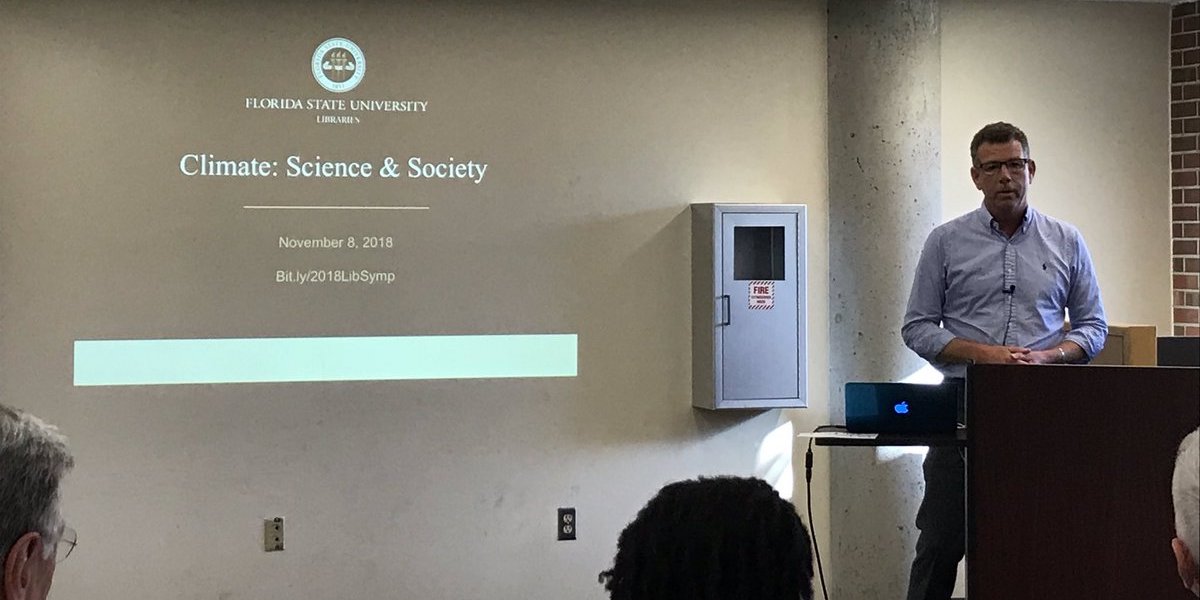The Florida Climate Center serves as the primary resource for climate data, information, and services in the state of Florida.
What's new in our world?
The Florida Climate Center achieves its mission by providing climate monitoring, research, and expertise to be applied by the people, institutions, and businesses of Florida and the surrounding region.
We provide direct service by fulfilling requests for climate and weather data and information in a variety of formats.
We perform research that advances the understanding of the climate variability and changes of Florida and the surrounding region.
We provide outreach in presentations and at events aimed at a variety of groups, interests, and ages.
Prepared by Daniel J. Brouillette
Florida Climate Center
The Florida State University
Tallahassee, FL
Mean temperatures in September were above normal statewide. The anomalies in the northern and west-central parts of the state were the greatest (Table 1 and Appendix 1). Continuing a long-term trend, anomalies in monthly mean minimum temperature were more positive than anomalies in monthly mean maximum temperatures. September 2018 was the warmest on record at Gainesville, Daytona Beach, Tampa, Melbourne, and Key West, as well as other less major stations, and in the top five warmest on record at several other stations. Several high temperature records were tied or broken across the state (Appendix 2).
Table 1. September average temperatures and departures from normal (˚F) for selected cities.
| Station | Mean Temperature | Departure from Normal |
| Pensacola | 82.0 | +3.6 |
| Tallahassee | 82.7 | +4.5 |
| Jacksonville | 82.4 | +4.2 |
| Orlando | 83.4 | +2.3 |
| Tampa | 85.9 | +4.2 |
| Miami | 83.3 | +0.4 |
| Key West | 85.8 | +2.6 |
Rainfall totals in September were below normal except in the far southern part of the state, in the Tampa Bay area, and on much of the panhandle (Figure 1). The third-wettest September on record was registered at Pensacola, and Daytona Beach and Melbourne both had the second-driest September on record, with several other stations in the eastern half of the peninsula in the top 10 driest Septembers on record. Two 24-hour precipitation records were broken for the month (Table 3).
Table 2. September precipitation totals and departures from normal (inches) for selected cities.
| Station | Total Rainfall | Departure from Normal |
| Pensacola | 18.25 | +12.27 |
| Tallahassee | 4.07 | -0.62 |
| Jacksonville | 3.41 | -4.78 |
| Orlando | 1.91 | -4.15 |
| Tampa | 9.20 | +2.90 |
| Miami | 7.89 | -1.97 |
| Key West | 6.08 | -0.63 |
Table 3. Select daily rainfall records (inches) broken during September. (Compiled from NOAA, NWS)
| Date | Location | Record | Last |
| 5 | Pensacola | 5.98 | 1.77 in 1920 |
| 14 | Key West | 2.59 | 1.83 in 1997 |
Figure 1. A graphical depiction of the monthly rainfall departure from normal (inches) for September is given in the figure below (courtesy of NOAA, NWS).
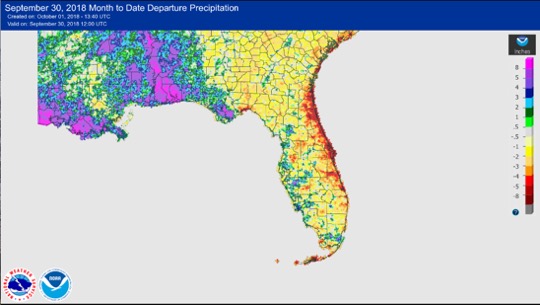
ENSO-neutral conditions are present in the Pacific, with El Niño favored to develop.
Based on current data and forecast models, forecasters with the Climate Prediction Center (CPC) continue with an El Niño Watch. ENSO-neutral conditions currently are present, with sea-surface temperatures (SST) near to above average across the equatorial Pacific Ocean. The chance of El Niño development during the climatological boreal autumn (from now through the end of November) is rated at 50-55% (a decrease in probability from last month) and at 65-70% during the climatological boreal winter (December-January-February). The CPC seasonal outlook favors above-normal temperatures and above-normal precipitation over the northern two-thirds of the state and equal chances of above-, near-, and below-normal precipitation in the southern one-third through October 2018. For the balance of the climatological autumn as a whole (through the end of November), there is an enhanced probability of above-normal precipitation statewide, with above-normal temperatures favored in the southern half of the state and equal chances of above-, near-, and below-normal temperatures favored in the northern half.
Hazardous Weather Events in September.
According the Local Storm Reports (LSRs) issued by the local National Weather Service (NWS) offices serving Florida, 143 instances of hazardous weather were reported across the state in September 2018.
Table 4. Breakdown of storm reports submitted in Florida during the month of September. (Compiled from Iowa State University/Iowa Environmental Mesonet.)
| Report Type | Number of Reports |
| Storm Damage | 34 |
| High Winds | 54 |
| Dense Fog | 0 |
| Hail | 8 |
| Tornadoes/Funnel Clouds/Waterspouts | 21 |
| Heavy Rain | 2 |
| Fire | 0 |
| Flooding | 17 |
| Lightning | 3 |
| Heat | 0 |
| Coastal Hazards/Rip Currents | 4 |
Drought-Related Impacts
At the end of September, according to the U.S. Drought Monitor, all of Florida was drought-free, continuing conditions that have been present since the late spring. Rainfall deficits that had accumulated on the far western panhandle were eliminated by heavy rains from Tropical Storm Dennis at the beginning of the month.
As of 1 October, the Lake Okeechobee water level was at 14.53 ft. above sea level, which is above average for this time of the year.
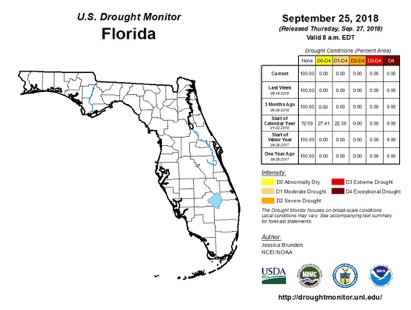
Agriculture-Related Impacts.
At the end of September, topsoil-moisture levels were mainly adequate, although about one-fifth of the state had very short or short topsoil-moisture levels and one-fifth had surplus moisture.
At the start of the month, Tropical Storm Gordon moved from just south of the Florida peninsula through the eastern Gulf of Mexico to a landfall point on the Mississippi coast. Heavy rainfall and strong winds were observed on the far western panhandle; agricultural impacts from this storm were fairly limited, although some cotton was reported blown down or twisted in Okaloosa County. Otherwise, the historically frequently wet conditions of summer gave way to drier conditions in most areas through the month, allowing for seasonal activities to progress with less hindrance. By month’s end, the peanut and hay harvest, slowed by wet conditions early in the month, was moving fast. As well, the harvest of avocado, bitter melon, boniato, malanga, and okra were underway. The planting of beans, bitter melon, boniato, carrots, leafy greens, malanga, okra, peppers, radishes, snap beans, sweet corn, and tomatoes was in progress.
Appendix 1
Additional September Departures from Normal Data for Florida Locations
| Station | Total rainfall (in.) | Departure from Normal (in.) | Average Temperature (˚F) | Departure from Normal (˚F) |
| Gainesville | 2.84 | -1.58 | 83.5 | +5.3 |
| Melbourne | 1.63 | -6.01 | 83.6 | +3.0 |
| Fort Lauderdale | 7.88 | -3.05 | 83.3 | +0.1 |
| Fort Myers | 4.95 | -3.36 | 83.1 | +0.7 |
Appendix 2
Select daily maximum and minimum temperature records (oF) tied or broken during September.
(Compiled from NOAA, NWS)
|
Date |
Station |
Type |
Value |
Broken/Tied |
Last |
|
15 |
Pensacola |
Max |
97 |
Broken |
95 in 1991 |
|
14 |
Gainesville |
Max |
96 |
Tied |
96 in 1952 |
|
15 |
Gainesville |
Max |
97 |
Broken |
96 in 1972 |
|
16 |
Gainesville |
High Min |
81* |
Broken |
79 in 2004 |
|
17 |
Gainesville |
High Min |
75 |
Tied |
75 in 1969 |
|
5 |
Orlando |
High Min |
77 |
Tied |
77 in 1932 |
|
18 |
Orlando |
High Min |
76 |
Tied |
76 in 2016 |
|
28 |
Orlando |
High Min |
77 |
Tied |
77 in 1903 |
|
5 |
Melbourne |
High Min |
81 |
Broken |
80 in 1991 |
|
15 |
Melbourne |
Max |
96 |
Broken |
94 in 1938 |
|
22 |
Melbourne |
High Min |
80 |
Tied |
80 in 2009 |
|
29 |
Melbourne |
High Min |
82 |
Broken |
80 in 1989 |
|
30 |
Melbourne |
High Min |
81 |
Broken |
78 in 2007 |
|
12 |
Tampa |
Max |
95 |
Broken |
94 in 2008 |
|
15 |
Tampa |
High Min |
83 |
Broken |
80 in 2016 |
|
16 |
Tampa |
High Min |
84** |
Broken |
80 in 1933 |
|
17 |
Tampa |
High Min |
82 |
Broken |
80 in 1996 |
|
20 |
Tampa |
Max |
96 |
Broken |
94 in 2017 |
|
24 |
Tampa |
Max |
95 |
Broken |
94 in 1930 |
|
26 |
Tampa |
Max |
95 |
Broken |
94 in 1986 |
|
29 |
Tampa |
Max |
97 |
Broken |
93 in 2002 |
|
30 |
Tampa |
Max |
97*** |
Broken |
93 in 2005 |
|
3 |
Miami |
High Min |
81 |
Tied |
81 in 1945 |
|
17 |
Miami |
High Min |
81 |
Tied |
81 in 1988 |
|
27 |
Miami |
High Min |
82 |
Broken |
81 in 1989 |
|
25 |
Fort Lauderdale |
High Min |
81 |
Broken |
80 in 2017 |
|
26 |
Fort Lauderdale |
High Min |
82 |
Tied |
82 in 1998 |
*This value breaks the all-time highest minimum temperature ever recorded at Gainesville for the month of September (records back to 1890), last set on 16 September 2004.
**This value breaks the all-time highest minimum temperature ever recorded at Tampa for the month of September (records back to 1890), last set on 15 September 2018 and before that on 11 September 2015.
***This value breaks the all-time highest maximum temperature ever recorded at Tampa for the month of September (records back to 1890), last set on 29 September 2018 and before that on 20 September 2018 and 7 September 1991.
Prepared by Lydia Stefanova and David F. Zierden.
Florida Climate Center
The Florida State University
Tallahassee, FL
Average temperatures were above normal across the state in March. The departures from average temperatures in March 2016 were above normal across the entire state, ranging from +2.1˚F in Key West to +5.9˚F in Melbourne (Table 1 and Appendix 1). March 2016 was the 3rd warmest on record for Miami and 4th warmest on record for West Palm Beach. A few maximum and minimum temperature records were tied or broken across the state in March (Appendix 2).
Table 1: March average temperatures and departures from normal (˚F) for selected cities.
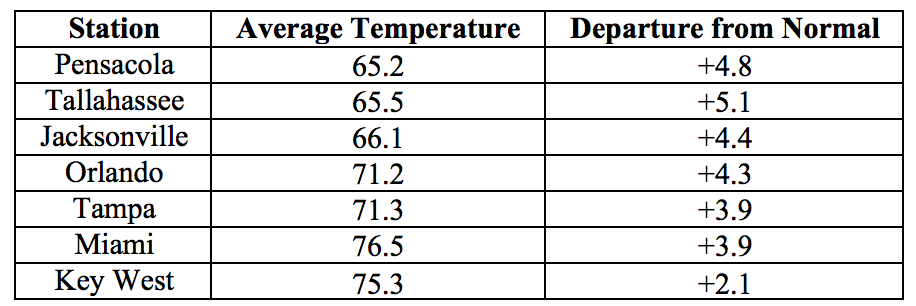
Rainfall totals in March were varied across the state. The Florida Panhandle, from the Alabama border to the Big Bend, had above-average rainfall, while the remainder of the state had mostly below-average rainfall (Figure 1). Large portions of South Florida received less than half of the normal rainfall for the month, although pockets in Broward, Palm Beach, Osceola and Park Counties received more than double the normal amount. Major reporting stations registered departures from normal ranging from -2.39” in Miami to +1.84” in Pensacola (Table 2 and Appendix 1), although localized parts of the state saw rainfall totals that were as much as 3” below normal to 5” above normal (Figure 1). None of the major reporting stations had 24-hour precipitation records broken during this month.
Table 2: March precipitation totals and departures from normal (inches) for select cities.

Figure 1: A graphical depiction of the monthly rainfall departure from normal (inches) for March is given in the figure below (courtesy of NOAA, NWS).
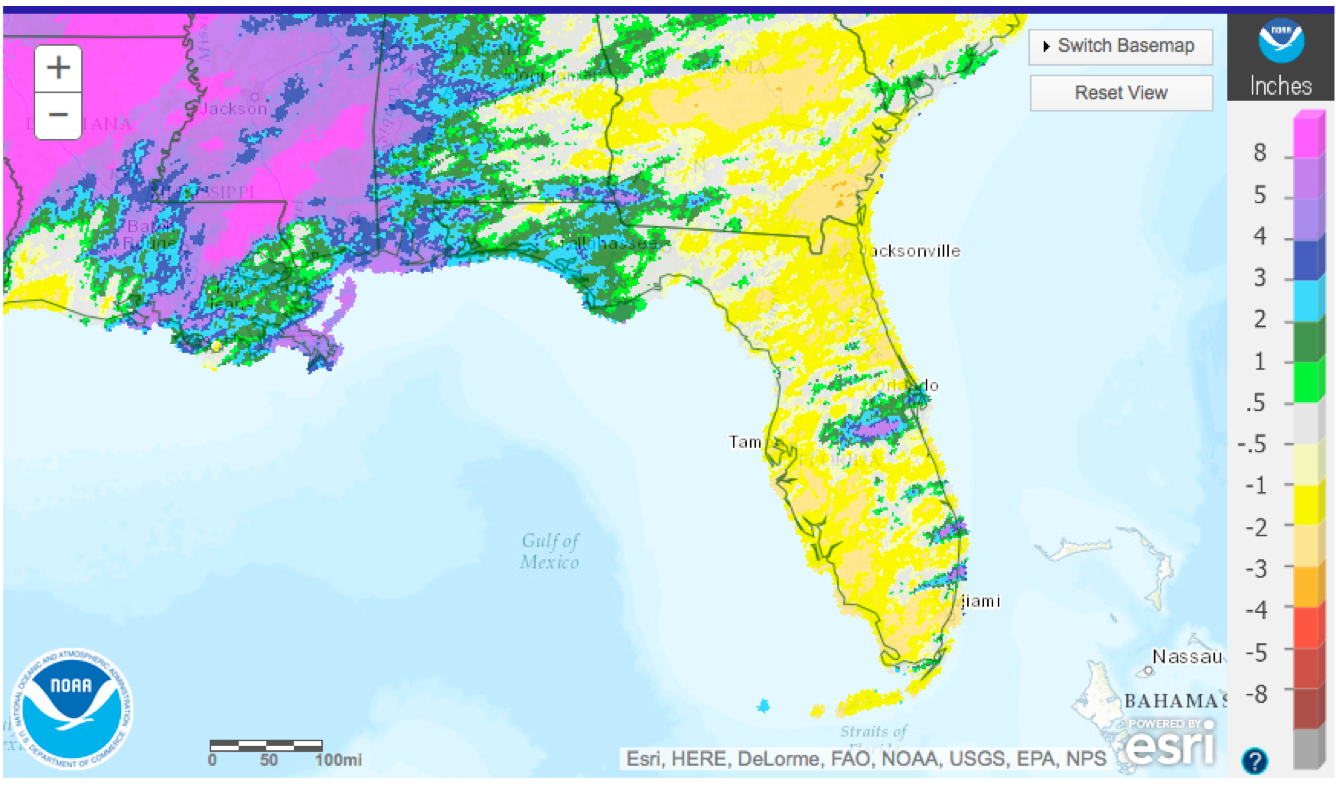
El Niño Conditions are Present in the Pacific.
Based on current data and forecast models, the Climate Prediction Center (CPC) will keep the ENSO Alert System at an El Niño Advisory. A strong El Niño is present and weakening. Positive equatorial sea surface temperatures (SST) anomalies continue across most of the Pacific Ocean. A transition to ENSO-neutral is likely during late spring or early summer 2016, with close to 50% chance for La Niña conditions to develop by fall.
Hazardous Weather Events in March.
There were a total of 265 severe weather reports made in Florida during March. The great majority of these, 242 reports, came from the second half of the month. Because of dry weather in the first half of the month, several small wildfires were reported around northeast Florida and were quickly contained. A frontal passage on the third of the month brought little rain but the strong winds caused a small amount of storm damage, mostly downed trees, along the Panhandle. A second front moved over the state between March 17th and 19th, bringing more strong winds and storm damage to the area, and reports of nickel- and quarter-sized hail in Walton and Bay Counties, and smaller-sized hail in Palm Beach and Collier Counties. A tornado was reported in Fort Lauderdale, overturning a few small boats on the beach and blowing down some signs, but causing no significant damage, before moving over the water. A series of fronts impacted the state between the 24th and 30th. Up to one-inch hail was reported in Escambia, Okeechobee, Brevard, and Polk Counties on the 24th; Bay, Hillsborough, Broward, and St Lucie on the 25th; Hillsborough, Polk, Osceola, Lake, Escambia and Santa Rosa Counties on the 26th; Orange County on the 28th; Sarasota, Polk, Miami-Dade, Broward, and Palm Beach Counties on the 29th. Lightning caused power outages along portions of coastal Flagler County on the 25th. One person was left in critical condition after a lightning strike in Martin County on the 25th, and three people sustained minor injuries after a lightning strike in Boca Raton on the 27th. A lightning struck a residence in West Palm Beach on the 30th, starting a small fire and leaving a hole in the roof. Strong winds and storm damage were reported throughout the state. Parts of Broward and Palm Beach Counties received over 5’’ of rain on the 24th and again on the 30th. Between the 24th and 27th parts of the Panhandle – Bay, Gadsden, Liberty, Calhoun, Jackson, Washington and Walton Counties – received rainfall totals of up to 10’’. Some associated flooding and road closures were reported in the affected areas.
Table 4: Breakdown of storm reports submitted in Florida during the month of March (Compiled from Southeast Regional Climate Center.)

Agriculture Related Impacts.
At the beginning of the month most (67%) topsoil moisture levels in the state were reported as adequate, although some (21%) surplus and some (12%) short values were reported as well. Low rainfall levels over much of the state dried out some of the surplus moisture, and by the end of the month, the coverage of adequate moisture levels increased to 73% and that of surplus values was reduced to 12%. The drier weather in most of the state was favorable for planting and harvesting activities, as well as for land preparation for planting. In parts of the Panhandle that saw excessive heavy rain, some re-working of fields prior to planting, and some replanting was necessary. Drier weather in south Florida made condition favorable for the increasing the pace of sugarcane harvesting. Fruits and vegetables in the area also benefitted from the warm sunny weather and the reduced disease pressure it brought, but all vegetable fields required irrigation. The great majority of the citrus growing region was drought-free throughout the month, with the exception of a few weeks in some of the northernmost counties, but nevertheless irrigation was wide spread. Most citrus trees are in full bloom and some are already developing fruit. Cattle are generally in good condition and pastures are improving seasonally due to the return to seasonally warming temperatures and mostly adequate soil moisture, although some pastures are exhibiting drought stress due to lack of sufficient rain.
Drought Related Impacts.
According to the US Drought Monitor, near the end of February the entire state had been rated drought-free. By the first of March abnormal dry conditions had set in over 8% of the state’s area. As the month progressed, abnormally dry conditions extended to about 20 percent of the state, including Alachua, Baker, Bradford, Clay, Columbia, Dixie, Duval, Flagler, Gilchrist, Hamilton, Lafayette, Levi, Madison, Marion, Nassau, Putnam, St Johns, Suwannee, Taylor, and Union counties. In all, roughly 2 million Florida citizens are currently affected by drought conditions. As of March 29th, the South Florida remains classified as drought-free despite the month’s significantly below-normal rainfall in the area thanks to the abundant excess rainfall received earlier in the year. Water levels at lake Okeechobee are still unusually high – about 15.1’, or 0.81’ above normal for this time of the year.
Appendix 1: Additional March departures from normal data for Florida locations.

Appendix 2: Select daily maximum and minimum temperature records (° F) broken during March (compiled from NOAA, NWS).
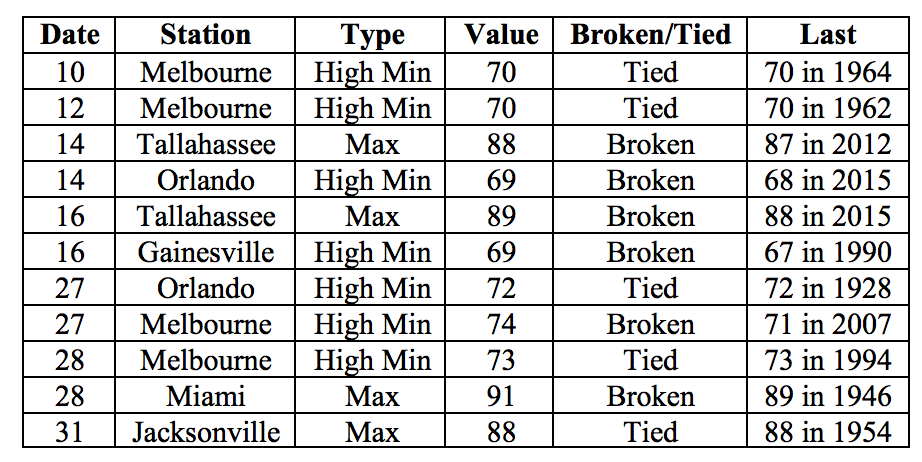
Prepared by Lydia Stefanova and David F. Zierden.
Florida Climate Center
The Florida State University
Tallahassee, FL
Average temperatures in October were above normal across most of the state. The departures from average temperatures in October 2015 were mostly near normal to above normal across the entire state, ranging from -1.4˚F in Apalachicola to 2.8˚F in Tallahassee (Table 1 and Appendix 1). Despite the warm monthly average temperatures, Fort Myers was the only major reporting stations to register a maximum temperature at or above 95˚F. October 2015 was the 5th warmest on record in Vero Beach, 8th warmest in Fort Lauderdale, Key West, and Tampa. Multiple maximum and minimum temperature records were tied or broken across the state in October (Appendix 2).
Table 1: October average temperatures and departures from normal (˚F) for selected cities.
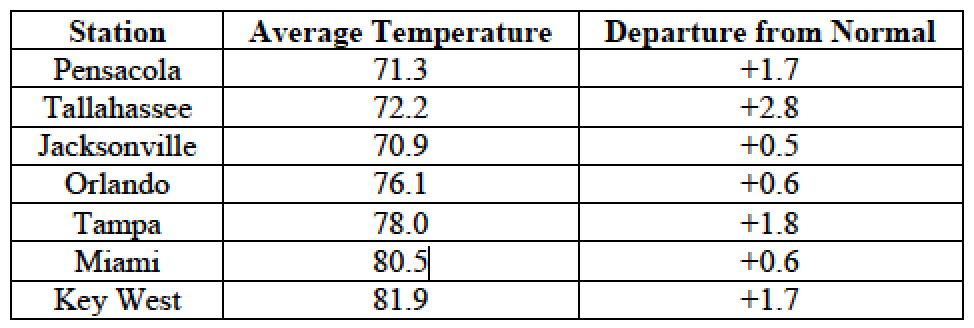
Rainfall totals were varied across the state in October.Most of the state had well below normal rainfall, although parts of the western Panhandle had above normal rainfall (Figure 1). Major reporting stations registered departures from normal ranging from -4.18” to +2.83” (Table 2 and Appendix 1), although localized parts of the state saw rainfall totals that were as much as 5” below normal to 4” above normal (Figure 1). October 2015 was the 2nd driest on record for Key West and West Palm Beach, 4th driest for Titusville, 6th driest for Jacksonville, and 10th driest for Daytona Beach. There were a small number of 24-hour precipitation records broken for the month (Table 3).
Table 2: October precipitation totals and departures from normal (inches) for select cities.

Table 3: Select daily rainfall records (inches) broken during October (compiled from NOAA, NWS).

Figure 1: A graphical depiction of the monthly rainfall departure from normal (inches) for October is given in the figure below (courtesy of NOAA, NWS).
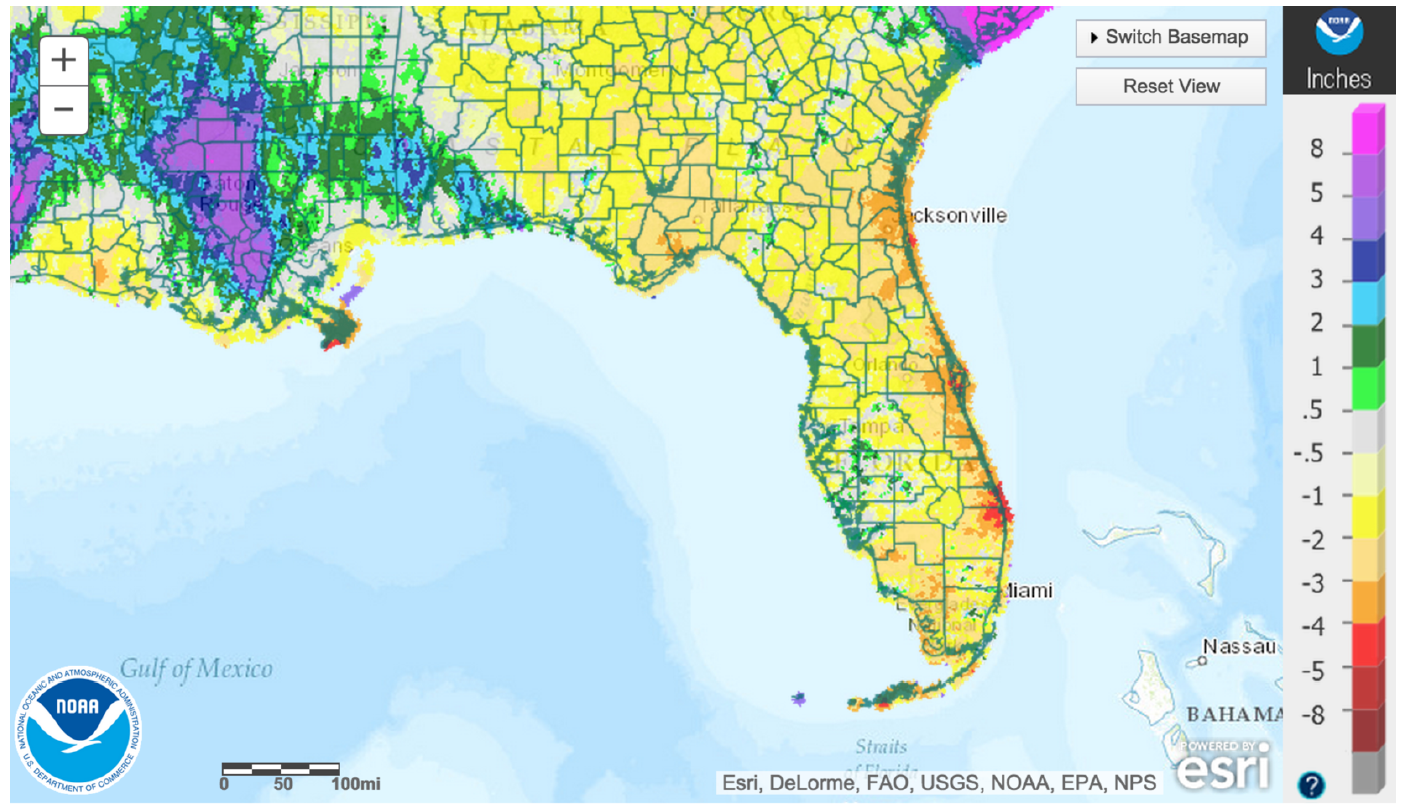
El Niño Conditions are Present in the Pacific.
Based on current data and forecast models, the Climate Prediction Center (CPC) will keep the ENSO Alert System at an El Niño Advisory. El Niño conditions are present, and positive equatorial sea surface temperatures (SST) anomalies continue across most of the Pacific Ocean. According to the CPC, there is approximately a 95% chance that El Niño conditions will continue through the Northern Hemisphere winter 2015-2016, gradually weakening through spring 2016. CPC predicts above normal temperatures and precipitation for November. This El Niño is currently very strong, on par with the landmark El Nino's of 1982/1983 and 1997/1998. Such a strong El Niño is sure to disrupt climate and weather patterns across the State throughout the winter and early spring seasons, most notably with frequent storms and rain and cooler temperatures. See this wrap-up of El Niño impacts on Florida on our website: http://climatecenter.fsu.edu/super-el-nino-poised-to-disrupt-weather-patterns.
Hazardous Weather Events in October.
There were a total of 111 severe weather reports were made in Florida during October, the majority of which were for high winds and flooding (see Table 4). A low-pressure trough brought heavy rain and consequent flooding to portions of South Florida on October 7th. Some of the flooding resulted in street and road closures due to standing water. This was followed by unusually high tides causing widespread coastal flooding from Miami Beach to Fort Lauderdale between October 8th and 9th and again on October 25th through 28th. Coastal flooding was also reported in the area of Jacksonville and the St. Johns River on October 6th and 27th. Several waterspouts were reported between October 10th-15th in the Florida Keys and the Miami area, and three waterspout reports were filed on October 31st near Miami. On October 11th, a waterspout briefly came onshore near St. Petersburg as a F0 tornado, damaging an 18-wheeler and causing minor damage to trees and road signs, before returning over the water. Multiple instances of high winds with gusts around 40 mph were reported throughout the day on October 19th and 20th along the Florida Keys. Numerous high wind and flooding reports were associated with a frontal system sweeping across the Florida Panhandle on October 26th-27th. It brought strong onshore winds with gusts (some up to 50 mph, leading to closing of Navarre Beach Pier) along the Florida Panhandle, causing coastal flooding and power flashes and outages in and around Panama City.
Table 4: Breakdown of storm reports submitted in Florida during the month of October (Compiled from Southeast Regional Climate Center.)
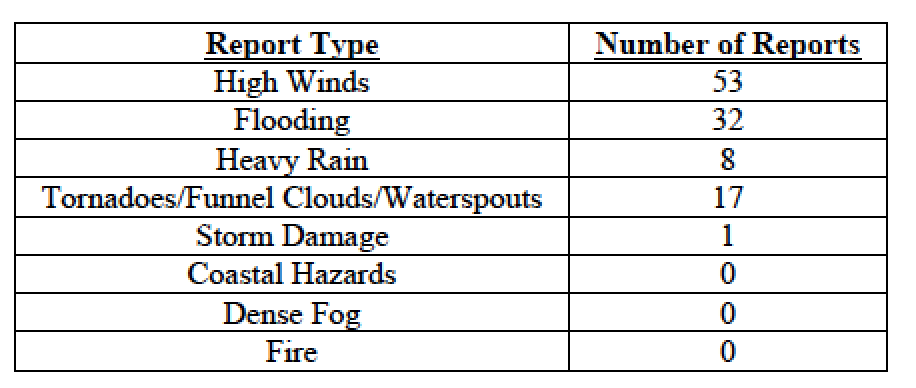
Agriculture Related Impacts.
At the beginning of October, topsoil moisture levels were at mainly (78%) adequate, though some (17%) surplus values were reported across the state. By the end of the month, topsoil moisture levels were still mainly (75%) adequate, but some (19%) short values were reported. Peanut harvesting was completed at 55% by the first week of October; peanut yields and quality were very poor in Santa Rosa County due to wet conditions. Despite delays in harvesting due to rain and cloudy weather in some locations in the middle of the month, the peanut harvesting was completed at 89%, ahead of the five-year average, thanks to drier weather towards the month’s end. Cotton harvest was initially delayed in Walton County due to standing water, and some cotton had been defoliated in Washington County. Cotton harvest continued throughout the month in Jackson, Walton, and Washington counties. Haying was active in Columbia, Dixie, Pasco, Orange, Seminole, and St. Lucie Counties, with some setbacks in Orange and Seminole Counties due to wet conditions. Some farmers obtained only one cutting of hay and quality was poor due to previous rainfall. Fruit and Vegetables: Early in the month, Flagler and Putnam county farmers were behind on planting cabbage and leafy greens due to wet conditions. Drier weather in Charlotte, Collier, Glades, Hendry, and Lee counties allowed vegetable growers to catch up on planting. All crops were irrigated. Livestock and Pastures: Some pastures in Lee County had standing water while winter pastures in Jefferson County need rain. Summer and permanent pastures across the State declined seasonally. Statewide, the cattle and pasture condition was mostly good. Citrus: Conditions were favorable for citrus growers throughout the region. The citrus-growing region was seasonably warm, with lots of sunshine and little rain, but remaining drought-free through the month of October.
Drought Related Impacts.
At the end of September, most (83%) of the state was drought-free, while roughly 17% of the state (mainly counties along the northern portion of the Florida Panhandle and portions of Broward, Dade, Monroe, and Palm Beach counties) was experiencing abnormally dry (D0) or moderate drought (D1) conditions. D1 conditions were present in parts of Dade, Escambia, Jackson, Gadsden, Leon, Jefferson and Madison counties. The abnormally dry portions of Broward and Palm Beach County reverted to drought-free with the help of a good rain on October 17th. As October progressed, D1 conditions briefly broadened in the extreme western Panhandle, but a frontal passage over the area brought heavy rains on October 26-27 and significantly eased the drought conditions in the region. Despite the overall rain deficit for the month, roughly 86% of the state is now drought-free. Abnormally dry (D0) conditions are still present in Santa Rosa, Okaloosa, Jackson, Calhoun, Liberty, Taylor, Madison, Monroe and Dade counties. Moderate (D1) drought extends over Gadsden, Jefferson and Leon County, and in parts of Jackson and Madison County. In all, drought conditions are reported in about 14% of the state, currently affecting roughly 370 thousand Florida citizens. The water level in Lake Okeechobee at the end of the month is about 14.6 ft., slightly down from the beginning of the month.
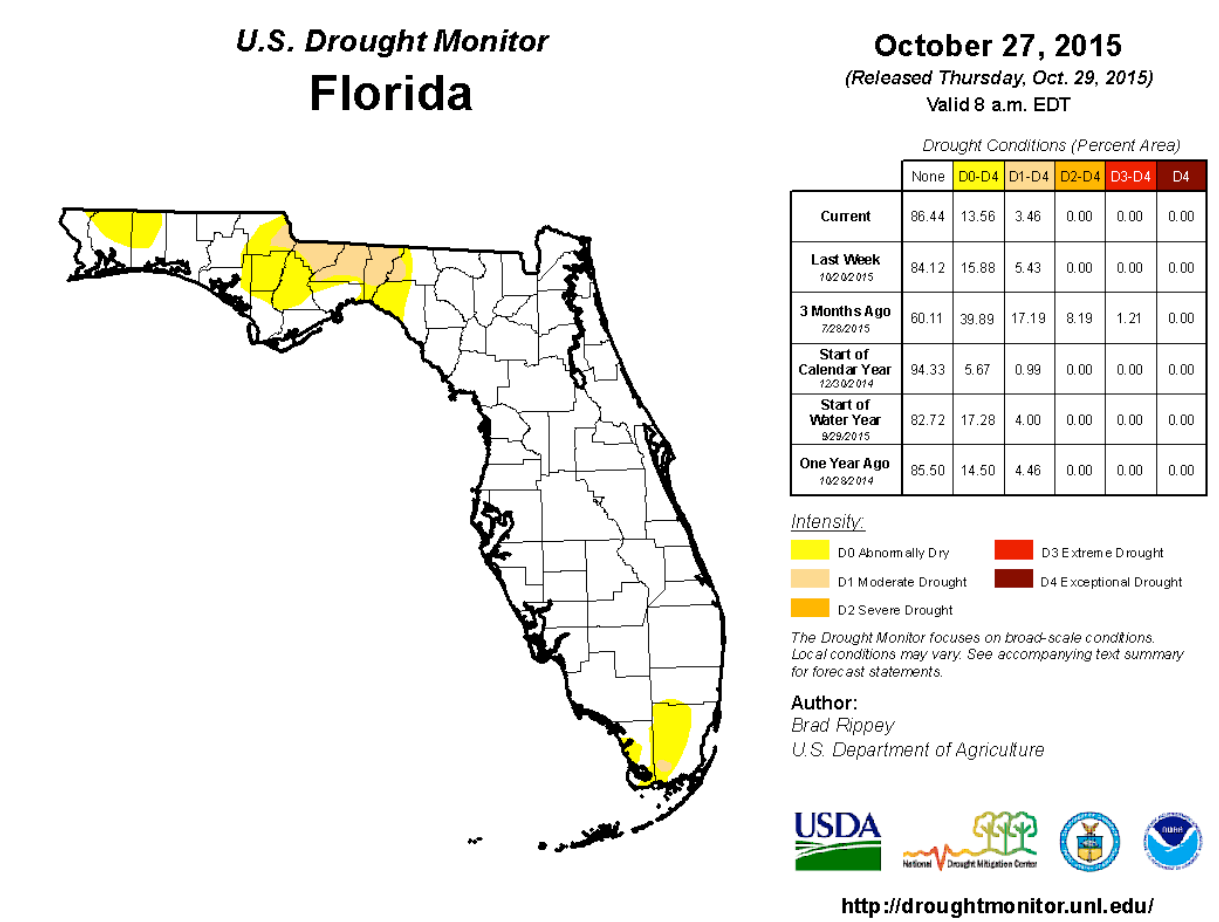
Appendix 1: Additional October departures from normal data for Florida locations.

Appendix 2: Select daily maximum and minimum temperature records (° F) tied or broken during October (compiled from NOAA, NWS).



